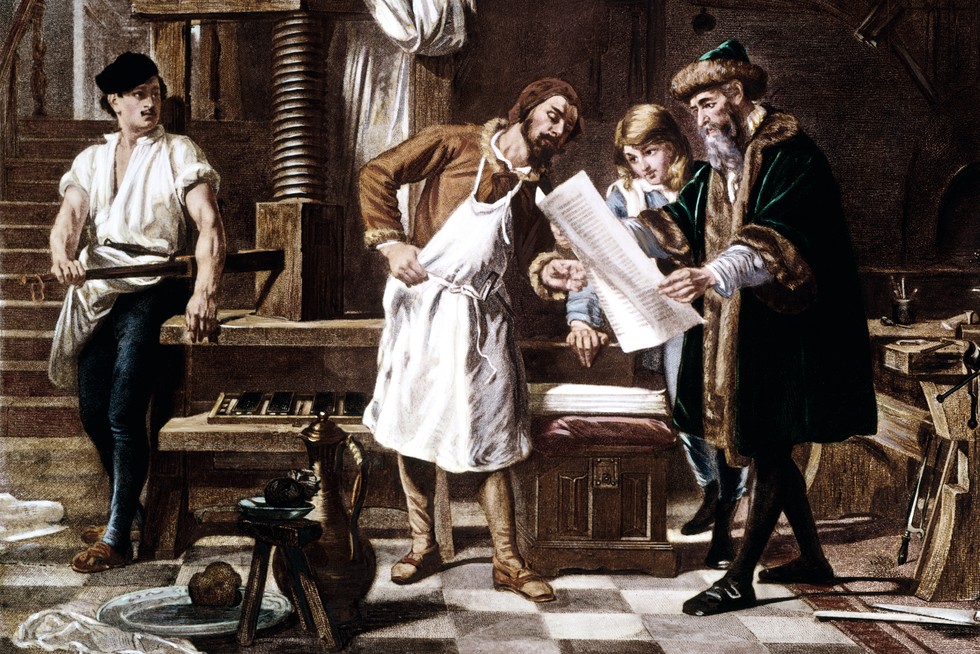Who invented the printing press?
The invention of the printing press changed the world, enabling the spread of knowledge like never before. As Danny Bird reveals, it brought together centuries of innovation at the right place and time

Who invented printing?
There is some debate about where and when printing first developed. Although the ancient Egyptians used woodblock printing to mark textiles, the technology was refined in China and Korea, probably around the sixth century AD.
Crucial to that later development, however, was the development of papermaking in China. The process pioneered during the Han dynasty – according to tradition, in AD 105 – involved pulping rags, mulberry fibres and hemp waste with water. Engravers carved whole texts into wooden blocks that were coated with ink and pressed onto paper, producing facsimiles.
The earliest-known printed texts were produced using this technique, including the oldest extant book – the Diamond Sutra by Wang Jie, printed in AD 868.
For six centuries, the Chinese kept papermaking a closely guarded secret. But following the defeat of the Tang dynasty at the battle of Talas in 751, the Muslim rulers of the Abbasid Caliphate extracted details from Chinese prisoners of war.
Paper mills soon proliferated in Samarkand, a major centre of learning on the Silk Road in what is now Uzbekistan, exporting the commodity throughout the Islamic world.
Eventually, knowledge of the process reached Europe, where paper was first produced in 1151 in Xàtiva inal-Andalus, the Muslim-ruled tract of the Iberian Peninsula.
How was knowledge preserved prior to printing?
The arrival of papermaking in Europe proved instrumental in the eventual success of modern printing.
For centuries, reeds harvested from the banks of the Nile had been used to make papyrus on which information could be recorded. Rome’s annexation of Egypt in 30 BC gave the empire a monopoly over its production.
Books – albeit handwritten by scribes on papyrus scrolls – were commonplace across the Mediterranean Basin until the fracturing and decline of the Roman empire in the fifth century AD.
In East Asia, meanwhile, durable and affordable paper was in plentiful supply, and bound blank notebooks were available to buy.
In Europe, the start of the Middle Ages saw a schism within Christianity between Rome and Constantinople (now Istanbul). Biblical scholars depended on a limited supply of vellum (calfskin parchment) to preserve and reproduce scripture.
Copying text onto vellum was a time-consuming and extremely costly process. Scribes would work long hours, sometimes in special rooms within monasteries known as scriptoria, copying out reams of text by hand – with errors unsurprisingly common – painstakingly creating beautifully illuminated manuscripts.
Who invented moveable type?
Even after knowledge of papermaking had spread to Europe, typography remained a largely East Asian skill.
Evidence suggests that Chinese printer Pi Sheng had developed moveable type made from clay in the 1040s.
Then, in 1403, the Korean monarch Taejong oversaw the manufacture of around 100,000 pieces of type.
Soon after, the use of woodblock printing began to take off in Europe. But the fragility of wood soon prompted experimentation with more durable materials.
Who invented the printing press?
Johannes Gutenberg, born probably in the 1390s in Mainz (then within the Holy Roman Empire), is credited with inventing the printing press.
A skilled metalworker and inventor, he is also acknowledged as the first person to mass-produce resilient, standardised type.
To create dies, each letter of the Latin alphabet was carved into a soft metal, such as bronze. That was then coated with molten lead to form a mould, into which an alloy of lead, tin and antimony was poured to cast the type.
Gutenberg emulated the block-like design of the Latin characters typical of manuscripts, yielding a close facsimile of the font common throughout Catholic Europe at the time.
Why was the printing press important?
Gutenberg’s printing press enabled the mass production of printed works at a speed and quality never seen before.
The printing press transformed the production of documents, drawing on the earlier principles of woodblock printing and technology used in the production of wine and olive oil.
Type was arranged in lines, bound into a sturdy frame, inked, then pressed into paper to form an impression.
Having revolutionised the printing process, Gutenberg’s approach to the aesthetic of the finished product remained conservative.
What were the first printed books to be produced?
Gutenberg’s earliest project – the first book printed in the western world – was his 42-line Bible.
First appearing in the mid-1450s, several copies were initially printed on parchment and adorned with the kind of artistry more typical of medieval illuminated manuscripts.
Printing workshops soon spread across the continent, churning out a plethora of printed material.
Works produced before 1501 are known as incunabula (from the Latin for ‘cradle’). Notable among early adopters of the new technology was Venetian humanist Aldous Manutius, who printed ancient Greek and Roman texts in portable and affordable formats, reflecting rising literacy rates.
What was the impact of the printing press on the Islamic world?
Venice quickly became a major commercial port for printers. In the late 1530s, the Qur’an was printed by Paganino Paganini and his son in the city. Though this seemed a good business opportunity, given the millions of devout Muslims living in the Ottoman empire, the venture ultimately failed.
Unlike its Latin counterpart, the cursive style of Arabic script was more difficult to translate into moveable type. Moreover, the art of Arabic calligraphy still garnered huge prestige, and Ottoman scholars continued to rely heavily on handwritten texts into the 19th century.
What has been the legacy of the printing press?
Tellingly, the advent of the printing press coincided with the end of the Middle Ages.
It sent book prices plummeting and, with greater access to learning, new ideas swept Europe, expediting the ‘recovery’ of Classical knowledge and giving impetus to the Renaissance.
Theologian Martin Luther’s critique of Catholic doctrine in his Ninety-five Theses was a significant beneficiary of the new medium: quickly appearing in print, it went viral in 1517, kickstarting the Protestant Reformation.
Subsequently, the luminaries of the Scientific Revolution depended heavily on printed works to critique and advance theories.
Combining ancient technologies, Gutenberg’s press launched an information revolution – the legacy of which still reverberates in the frenetic digital age we are navigating today.
This content first appeared in the June 2023 issue of BBC History Revealed
Authors

Danny Bird is the Staff Writer at BBC History Revealed, responsible for researching and producing the magazine’s features

Start the year with a subscription to BBC History Magazine - £5 for your first 5 issues!
As a print subscriber you also get FREE membership to HistoryExtra.com worth £34.99 + 50% London Art Fair 2024 Tickets




